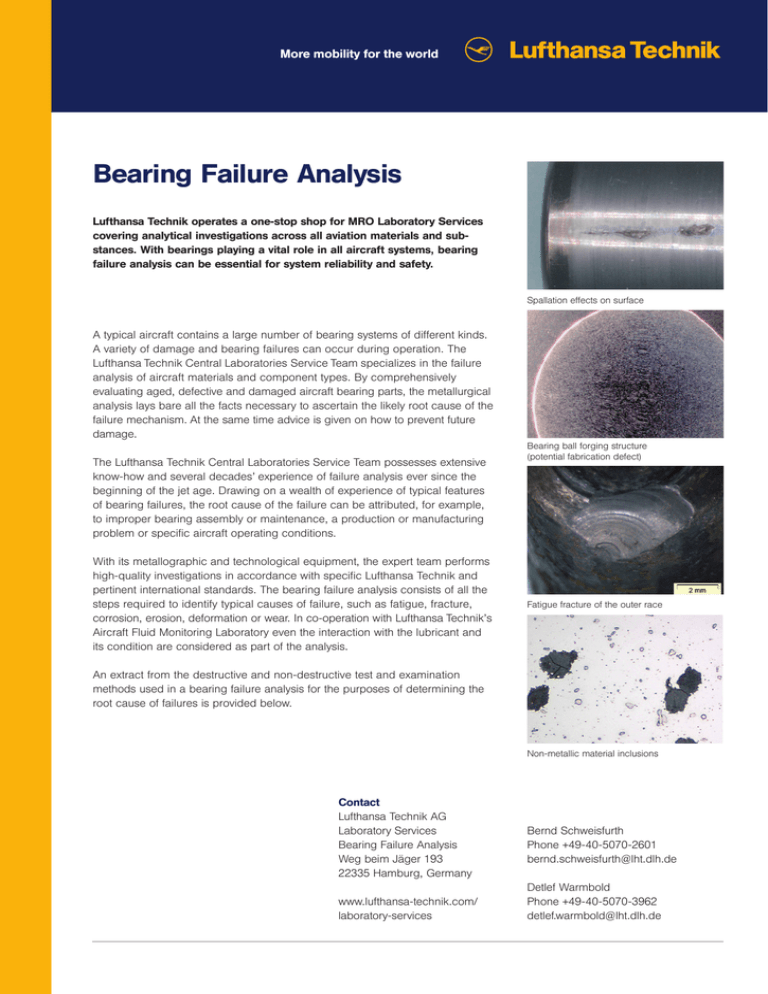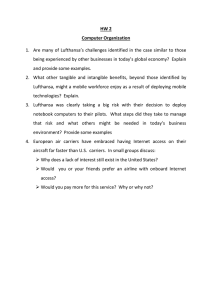
More mobility for the world
Bearing Failure Analysis
Lufthansa Technik operates a one-stop shop for MRO Laboratory Services
covering analytical investigations across all aviation materials and substances. With bearings playing a vital role in all aircraft systems, bearing
failure analysis can be essential for system reliability and safety.
Spallation effects on surface
A typical aircraft contains a large number of bearing systems of different kinds.
A variety of damage and bearing failures can occur during operation. The
Lufthansa Technik Central Laboratories Service Team specializes in the failure
analysis of aircraft materials and component types. By comprehensively
evaluating aged, defective and damaged aircraft bearing parts, the metallurgical
analysis lays bare all the facts necessary to ascertain the likely root cause of the
failure mechanism. At the same time advice is given on how to prevent future
damage.
The Lufthansa Technik Central Laboratories Service Team possesses extensive
know-how and several decades’ experience of failure analysis ever since the
beginning of the jet age. Drawing on a wealth of experience of typical features
of bearing failures, the root cause of the failure can be attributed, for example,
to improper bearing assembly or maintenance, a production or manufacturing
problem or specific aircraft operating conditions.
With its metallographic and technological equipment, the expert team performs
high-quality investigations in accordance with specific Lufthansa Technik and
pertinent international standards. The bearing failure analysis consists of all the
steps required to identify typical causes of failure, such as fatigue, fracture,
corrosion, erosion, deformation or wear. In co-operation with Lufthansa Technik’s
Aircraft Fluid Monitoring Laboratory even the interaction with the lubricant and
its condition are considered as part of the analysis.
Bearing ball forging structure
(potential fabrication defect)
Fatigue fracture of the outer race
An extract from the destructive and non-destructive test and examination
methods used in a bearing failure analysis for the purposes of determining the
root cause of failures is provided below.
Non-metallic material inclusions
Contact
Lufthansa Technik AG
Laboratory Services
Bearing Failure Analysis
Weg beim Jäger 193
22335 Hamburg, Germany
www.lufthansa-technik.com/
laboratory-services
Bernd Schweisfurth
Phone +49-40-5070-2601
bernd.schweisfurth@lht.dlh.de
Detlef Warmbold
Phone +49-40-5070-3962
detlef.warmbold@lht.dlh.de
Copyright © 2013 Lufthansa Technik. All rights reserved. Disclaimer in respect of statements and information. Nothing contained in this publication shall constitute any warranty, guarantee or liability for Lufthansa Technik AG,
its subsidiaries and affiliates but is for information purposes only. Accordingly, Lufthansa Technik AG, its subsidiaries and affiliates neither expressly nor conclusively accept responsibility or liability for the actuality, accuracy and
completeness of the statements and information contained in this publication. 09/13 | 500 | AW
More mobility for the world
Examinations
Specifications
1. Material composition and identification
Lufthansa Technik is able to identify the composition of metallic and
plastic/composite materials using several methods:
• Energy Dispersive Analysis by X-ray (EDX)
• Optical Emission Spectroscopy (OES, ICP-OES)
• Fourier Transformation Infrared Spectroscopy (FTIR) for
non-metal bearing components or residuals
2. Material condition
To evaluate the material condition Lufthansa Technik performs
various tests, such as:
• Hardness tests or micro-mechanical tests
• Metallographic examination
• (if necessary and available: Fluid analysis)
3. Component failure, surface and profile
To investigate the material surface and profile, Lufthansa Technik
uses a range of microscope equipment from light-optical
technologies to Scanning Electron Microscopy (SEM) in
combination with other metallographic examinations to:
• identify relevant surface profiles,
• achieve a high-resolution documentation of fracture structures,
• evaluate the fine granulation, phase distribution
4. Failure report and documentation
In the last step Lufthansa Technik provides a detailed failure report.
The complete bearing – preferably with
the relevant oil sample – is requested for
the initial system inspection and sampling.
Lufthansa prepares laboratory
samples of the bearing parts to perform
the mentioned investigations.
Lufthansa Technik prepares laboratory
samples of the bearing for investigation.
The report correlates findings and provides conclusive results, and if applicable,
recommendation.
How-to guide
Shipping address:
Required information:
If you are interested in trying our service,
we suggest that you proceed as follows:
1. Contact our Laboratory Service team
for any question regarding your component and tribological system failure.
2. We will send you an estimate of the
cost of performing your individual failure
analysis.
3. We recommend that your samples
are firmly sealed and clearly labelled.
The checklist below may help you with
preparing the component shipment.
Lufthansa Technik AG
Laboratory Services
Bearing Failure Analysis
Department HAM TQ/M-M
Building 250, Room 241/Bhf. 36
Weg beim Jäger 193
22335 Hamburg, Germany
• Customer/operator/part number
• Aircraft registration
• Engine type (if applicable)
• Engine S/N (if applicable)
• Bearing position
(e.g. bearing#4, AGB bearing)
• Bearing P/N and S/N
• Failure history
if available:
• Related tribological oil/grease sample
• Excerpt of relevant CMM
Supplementary:
• Purchase Order
• Contact information incl. e-mail address
Copyright © 2016 Lufthansa Technik. All rights reserved. Disclaimer in respect of statements and information. Nothing contained in this publication shall constitute any warranty, guarantee or liability for Lufthansa Technik AG,
its subsidiaries and affiliates but is for information purposes only. Accordingly, Lufthansa Technik AG, its subsidiaries and affiliates neither expressly nor conclusively accept responsibility or liability for the actuality, accuracy and
completeness of the statements and information contained in this publication. 03/16 | 500 | AW



